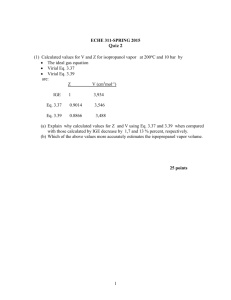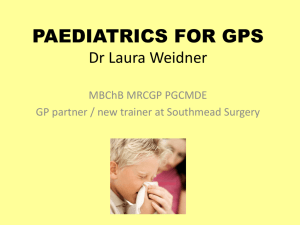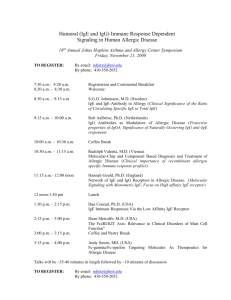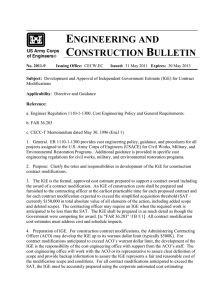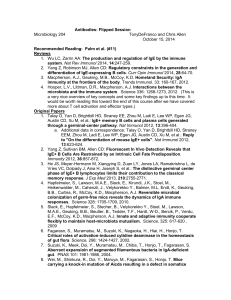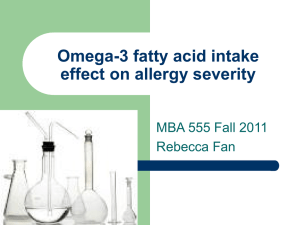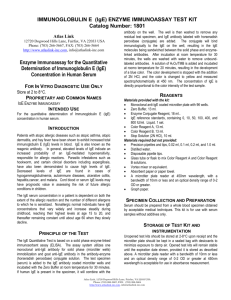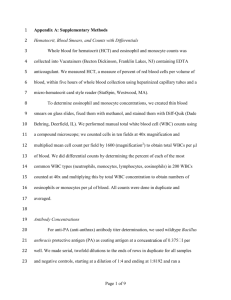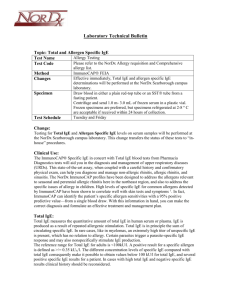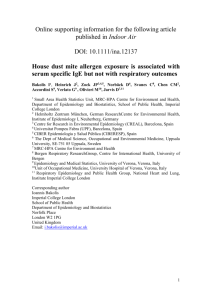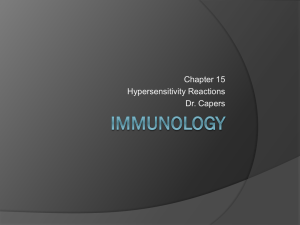IMMUNOGLOBULIN e
advertisement
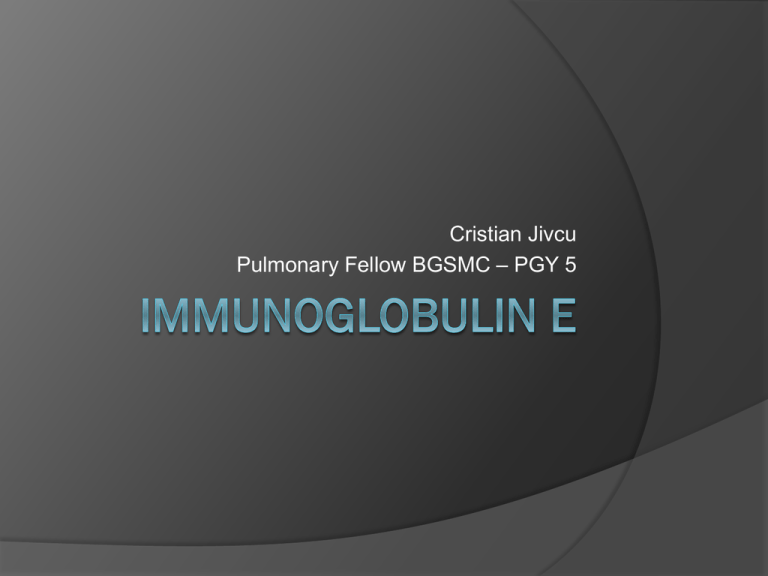
Cristian Jivcu Pulmonary Fellow BGSMC – PGY 5 Introduction 1 of 5 classes of antibodies (IgG, IgM, IgA, IgD and IgE) 0.002% of serum antibodies Half-life = 2 days Fc portion binds to mast cells and basophils where is mediates many allergic reactions. Fc portion binds to Eosinophils enabling opsonization against parasitic infections. IgE in Parasitic infections Activity of IgE in allergies Causes of Elevated IgE Category Most common Examples Allergic Disease Eczema, Rhinitis, Asthma, Drug Allergies, Urticaria, Extrinsic Alveolitis, ABPA Cestodes Echinococcus granulosus & multicularis Trematodes Schistosoma mansoni, japonicum & haematobium Nematodes Ascaris, Ancylostoma, Capillaria phillinpinesis, Toxocara cani & cati Monoclonal Gammopathy IgE monoclonal gammopathy Immune deficiency Hyper-IgE, Wiskott-Aldrich, DiGeorge, Nezelof, Graft vs Host, HIV Inflammatory Diseases Kawasaki, PAN, CF Infectious Leprosy, Aspergilloma, Coccidiomycosis Causes of Hyper IgE Most common cause of elevated IgE Western countries – allergies Third world – parasitic infections. Extreme levels (800 – 25,000IU/ml) Severe atopic dermatitis ABPA Parasitic infections IgE myeloma Buckley Syndrome (Job’s Syndrome or Hyper IgE syndrome) HIES Identified in 1966 by Davis Schaller Two girls w/ red hair, chronic dermatitis and recurrent staphylococcus abscesses Disease was named after the Biblical Job Hyper IgE Syndrome (HIES) Autosomal dominant or recessive Dominant – pts fail to lose primary teeth so can have two sets of teeth simultaneously Recessive – severe viral infections and neurologic sequelae, often fatal in childhood Characteristics: Frequent Staphylococcal skin infections Eczema-like skin rash Severe lung infections – pneumatoceles Very high levels of IgE (>2000 IU/ml) Pathophysiology Abnormal neutrophil chemotaxis (↓ interferon µ) is postulated as cause of disease. This defect proved inconsistently present. IgE usually >10x normal ↑ Eos are common in 90% Diagnosis Clinical diagnosis Immune defects Somatic defects Elevated IgE NIH developed a scoring system Not for clinical use Linkage studies to determine inheritance patterns. Treatment Chronic antibiotics – given repeated staph infections Diagnosis should ideally be made in childhood to prevent pneumatocele formation Good skin care I&D of abscesses Mucocutaneous candidiasis the most frequent co-infection. Treatment Typically pts are unaware of how sick they are Fever and other markers of inflammation may not be present. Empyema is frequently present and requires drainage. Pulmonary cavities are at high risk for co or super-infection. Extensive bronchiectasis. Treatment Immunomodulators have been unsuccessful Levamisole – only RTC INF-µ -- was inconsistent in its effects on IgE levels and infections. Cyclosporine A – used successfully in Israel but results not officially published. IVIG – reasonable option given that encapsulated organisms are most often at fault. References Grimbacher Bodo, Steven M Holland, Puck Jennifer, Hyper-IgE syndromes. Immunological Reviews 2005. Vol 203: 244-250 http://www.clinlabnavigator.com/TestInterpretations/immunoglobulin-e-ige.html Para FM – Extreme increase of total IgE with Eosinophilia, case report; Allergol Immunol Clin 2000;15:194-197.
